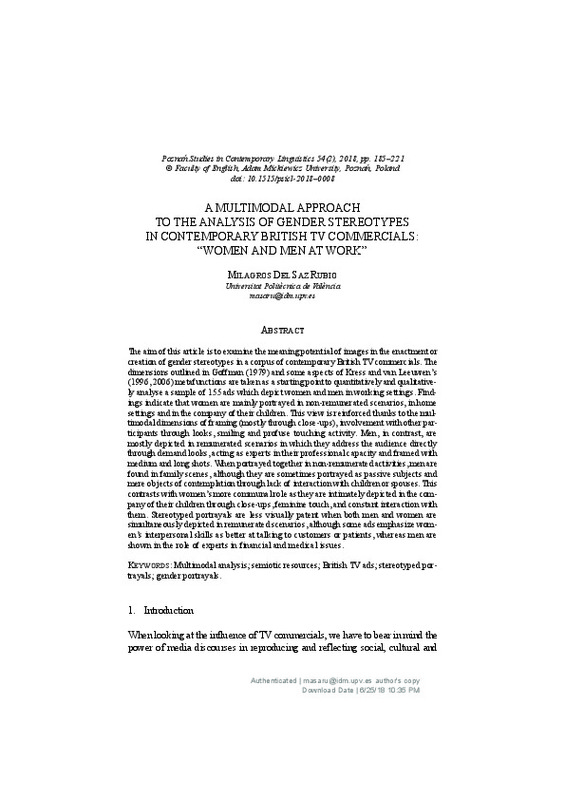JavaScript is disabled for your browser. Some features of this site may not work without it.
Buscar en RiuNet
Listar
Mi cuenta
Estadísticas
Ayuda RiuNet
Admin. UPV
A multimodal approach to the analysis of gender stereotypes in contemporary British TV commercials: Women and Men at work
Mostrar el registro sencillo del ítem
Ficheros en el ítem
| dc.contributor.author | Saz Rubio, María Milagros del
|
es_ES |
| dc.date.accessioned | 2019-09-26T10:25:36Z | |
| dc.date.available | 2019-09-26T10:25:36Z | |
| dc.date.issued | 2018 | es_ES |
| dc.identifier.uri | http://hdl.handle.net/10251/126429 | |
| dc.description.abstract | [EN] The aim of this article is to examine the meaning potential of images in the enactment or creation of gender stereotypes in a corpus of contemporary British TV commercials. The dimensions outlined in Goffman (1979) and some aspects of Kress and van Leeuwen's (1996, 2006) metafunctions are taken as a starting point to quantitatively and qualitatively analyse a sample of 155 ads which depict women and men in working settings. Findings indicate that women are mainly portrayed in non-remunerated scenarios, in home settings and in the company of their children. This view is reinforced thanks to the multimodal dimensions of framing (mostly through close-ups), involvement with other participants through looks, smiling and profuse touching activity. Men, in contrast, are mostly depicted in remunerated scenarios in which they address the audience directly through demand looks, acting as experts in their professional capacity and framed with medium and long shots. When portrayed together in non-remunerated activities, men are found in family scenes, although they are sometimes portrayed as passive subjects and mere objects of contemplation through lack of interaction with children or spouses. This contrasts with women's more communal role as they are intimately depicted in the company of their children through close-ups, feminine touch, and constant interaction with them. Stereotyped portrayals are less visually patent when both men and women are simultaneously depicted in remunerated scenarios, although some ads emphasize women's interpersonal skills as better at talking to customers or patients, whereas men are shown in the role of experts in financial and medical issues. | es_ES |
| dc.language | Inglés | es_ES |
| dc.publisher | Walter de Gruyter GmbH | es_ES |
| dc.relation.ispartof | Poznan Studies in Contemporary Linguistics (Online) | es_ES |
| dc.rights | Reserva de todos los derechos | es_ES |
| dc.subject | Multimodal analysis | es_ES |
| dc.subject | Semiotic resources | es_ES |
| dc.subject | British TV ads | es_ES |
| dc.subject | Gender portrayals | es_ES |
| dc.subject.classification | FILOLOGIA INGLESA | es_ES |
| dc.title | A multimodal approach to the analysis of gender stereotypes in contemporary British TV commercials: Women and Men at work | es_ES |
| dc.type | Artículo | es_ES |
| dc.identifier.doi | 10.1515/psicl-2018-0008 | es_ES |
| dc.rights.accessRights | Abierto | es_ES |
| dc.contributor.affiliation | Universitat Politècnica de València. Departamento de Lingüística Aplicada - Departament de Lingüística Aplicada | es_ES |
| dc.description.bibliographicCitation | Saz Rubio, MMD. (2018). A multimodal approach to the analysis of gender stereotypes in contemporary British TV commercials: Women and Men at work. Poznan Studies in Contemporary Linguistics (Online). 54(2):185-221. https://doi.org/10.1515/psicl-2018-0008 | es_ES |
| dc.description.accrualMethod | S | es_ES |
| dc.relation.publisherversion | http://doi.org/10.1515/psicl-2018-0008 | es_ES |
| dc.description.upvformatpinicio | 185 | es_ES |
| dc.description.upvformatpfin | 221 | es_ES |
| dc.type.version | info:eu-repo/semantics/publishedVersion | es_ES |
| dc.description.volume | 54 | es_ES |
| dc.description.issue | 2 | es_ES |
| dc.identifier.eissn | 1897-7499 | es_ES |
| dc.relation.pasarela | S\365260 | es_ES |








